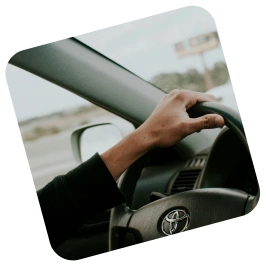When selling your car, it’s important to have all the necessary paperwork ready to facilitate a smooth transaction. Missing any documents can deter buyers or even halt the sale. So, by organising these documents before finalising the sale, you can reduce the risk of complications.
Being well-prepared is essential, as having the appropriate paperwork can also safeguard you against potential legal issues later.
Trust Carplus to guide you in finding the car you want with excellent terms that make your purchase both smooth and rewarding.
1. V5C – logbook

The V5C, the vehicle’s logbook, is fundamental when selling your car as it transfers ownership to the buyer. If you’re selling privately, you need to fill out sections 2 and 6. If you’re selling to a dealer, fill out section 4; dealers handle sending the entire V5C to the DVLA.
Selling a car without the logbook is possible but complicated and may deter buyers. If your V5C is lost, you can apply for a replacement online.
After a private sale, quickly send the completed sections to the DVLA to avoid liability for any tickets incurred before ownership is officially transferred. You can handle this process online via the DVLA’s website, where you’ll complete a form to transfer ownership. The new owner will then receive a new V5C confirming the registration in their name.
2. Four receipts
The buyer may need to arrange financing and will return a few days later with the remaining money. In the meantime, they can secure the car by placing a deposit, usually around 10% of the total price. When receiving a deposit, always provide the buyer with a receipt.
The receipt should include:
- Seller’s and buyer’s full names
- Vehicle details: make, model, registration number, VIN, mileage
- Amount of deposit
- Date of transaction
- Both parties’ signatures
Some sellers choose to specify a deadline by which the purchase must be completed, after which they retain the deposit. Make sure these conditions are clearly written on the receipt.
You’ll need two copies of the deposit receipt: one for yourself and one for the buyer. When they return to finalise the purchase, you’ll write out a similar receipt showing the remaining balance minus the deposit.
3. Service history
The service book, usually found in the owner’s manual folder, contains stamps showing when and what type of service was performed according to the manufacturer’s schedule. It’s important to make sure these stamps are updated every time the car is serviced. If your service book hasn’t been stamped, try to locate receipts for the services instead.
The service book details each service, including the type of maintenance, date performed, and mileage at the time. A thorough service history greatly increases your car’s resale value by showing it has been well cared for over the years.
These records should be handed over to the new owner so they can continue maintaining the car according to its service schedule. You may also offer a printed copy of the online service log if available.
4. MOT certificates

An MOT is an annual health check for your car that proves that it is roadworthy. Cars older than three years must have an MOT certificate to be legally driven, and potential buyers will want to see it, including any noted advisories.
While MOT certificates issued since 2006 are accessible online, it’s better to provide physical copies of certificates when selling, especially for older vehicles.
Meanwhile, you can easily verify a vehicle’s MOT status online. If you need a replacement certificate but don’t have a paper copy, any MOT centre can issue one for a fee. Provide your vehicle’s registration number and V5C reference to get a replacement certificate. This costs £10 or half the price of your last test, whichever is lower.
5. Insurance repairs
It’s unfortunate, but many cars will have encountered knocks, hits, or damage at some stage. Providing documentation of any repairs — whether done privately or through insurance — will reassure potential buyers. You might also consider showing the buyer documents related to any insurance claims you made for repairs.
After selling your car, notify your insurance provider to cancel coverage immediately to avoid unnecessary charges. Just bear in mind that there might be a cancellation fee.
6. Receipts for rarts
Similarly, it’s wise to keep receipts for any parts you’ve purchased. This is particularly important for older vehicles, where repairs might have been done at independent garages or if you’ve installed parts yourself.
When you have your car serviced or repaired, the garage should provide an invoice detailing the work performed and the parts used. This paperwork shows necessary upkeep and underscores the quality of parts used, which can be pivotal in closing the sale.
7. Car warranty

Many manufacturers now offer warranties lasting five or even seven years, so there may still be coverage left when you sell the car. If so, inform the warranty provider about the sale and let the buyer know how much of the warranty remains (if it’s transferable).
In most cases, warranties can be transferred to the new owner, and what’s even better, they increase your car’s value. This is because the new owner can continue to benefit from any remaining coverage. Clearly communicate to the buyer how much of the warranty is left and what the warranty’s terms are.
After you transfer the warranty, provide the new owner with any relevant documentation you have.
8. Finance settlement letter (if needed)
If the car you’re selling is still under a finance agreement, you’ll also require a valid finance settlement letter. This document will show the final settlement amount and the bank details of the finance company.
You’ll need to contact your finance provider to request this letter. Once you get the finance settlement letter, you can share it with buyers to be clear about any financial obligations tied to the vehicle. The buyer will use this information to arrange payment directly to the finance company
9. Car owner’s handbook
The owner’s manual is usually stored in the glovebox and provides essential information, such as how to recognise dashboard warning lights, maintain fluid levels, and check tyre pressure. The next owner will then have the necessary guidance for proper car maintenance and operation.
If you don’t have this document, you can buy a replacement directly from the manufacturer. While digital copies are available for free, getting a physical replacement helps maintain your car’s resale value. When requesting replacement manuals from some car manufacturers, you may need to provide the vehicle’s VIN number.
10. Proof of reservation and purchase receipts

One document you don’t need to prepare before agreeing to a sale is the sale agreement. However, it should be finalised as soon as both you and the buyer are ready to proceed. If you’re selling privately, you’ll be responsible for creating this document, but it’s crucial to have proof of the sale regardless of who you’re selling to.
This is essentially the same process described earlier, where you provide two receipts for each transaction involving the deposit and final payment. One receipt is kept by you as the seller, and the other is given to the buyer, ensuring both parties have documentation of the transaction details. This practice helps maintain clarity and accountability throughout the sale process.
Sell your car safely with Motorways
Final words
With these ten documents, you should be all set. Some are essential for making the sale possible and legal; others are mostly important for increasing the car’s value and reassuring potential buyers. But don’t skip any if you can avoid it.
V5C | Required |
Four receipts | Prefered |
Service history | Prefered |
MOT certificate | Required |
Insurance repairs | Prefered |
Receipts for parts | Prefered |
Car warranty | Prefered |
Finance settlement letter | Optional |
Owner’s handbook | Prefered |
Proof of reservation and purchase receipts | Required |
Although most car documentation is digital nowadays, it’s still wise to keep any physical paperwork you receive in a safe place indoors, organised in a folder. Each time you receive a new invoice or receipt, just add it to this folder. This keeps your documents easy to find and can also boost your car’s resale value by showing thorough record-keeping.
Best of luck with your sale!
Table of Contents








